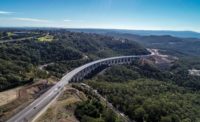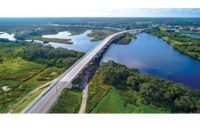Wilmington Bypass
Wilmington, N.C.
Best Project
Owner: North Carolina Dept. of Transportation
Lead Design Firm: H. W. Lochner Inc.
General Contractor: Balfour Beatty US
Designer: RS&H Architects-Engineers-Planners Inc.
Extending the Interstate 140 loop around Wilmington, N.C., is the $124-million Wilmington Bypass, completed in November 2017. Together with another section delivered by a different contractor, this roughly three-mile-long section completes a 15-year-long planning and development effort to relieve growing traffic congestion in New Hanover and Brunswick counties.
The section’s route through southeast North Carolina’s flat, marshy coastal plain required more than 2.2 million yd of borrow and 28,000 sq ft of mechanically stabilized earth walls for the approximately 1.5 miles of roadway. But it would be the twin 7,200-ft-long main bridges across the Cape Fear River and adjacent wetlands that posed the project’s biggest challenge.
Already limited to a state-imposed seven-month window to conduct in-water activities for foundation construction, the Balfour Beatty-led project team used a trestle approach to further minimize environmental impacts and a “leapfrogging” layout to reduce the overall amount of trestle needed
Although the strategy succeeded in reducing wetland impacts by 50% compared with a conventional construction method, it also created numerous logistical challenges. All material for pile-driving, substructure and girders had to be funneled up the new bridge and then down to the work trestle. Deliveries had to be scheduled and sequenced based on turnaround time and around other construction activities that also utilized the trestle.
The foundation for the wetland crossing consists of 24-in. and 30-in. prestressed concrete piles averaging 90 ft in length. Balfour Beatty self-performed pile-driving to prevent disruption to the tight schedule. Due to unexpected ground conditions, however, some piles required as many as 16 hours to achieve the minimum tip elevation. By resorting to double 12-hour shifts and round-the-clock work schedules, the project team completed all 184 piles for the bridges before the in-water activity period expired.
Together, the Wilmington Bypass structures total nearly 700,000 sq ft of bridge deck, 95,000 linear ft of pile, 57,000 linear ft of prestressed concrete girders and 38,000 yd of concrete. Post tensioned prestressed concrete girders and lightweight concrete were used for the Cape Fear River bridges’ 280-ft main spans.
The Wilmington Bypass was opened to traffic on November 2017 without incurring a single lost-time injury in more than four years of construction. Motorists crossing the Cape Fear River now enjoy a sweeping view of the still-pristine wetlands that the project team worked diligently to safeguard.








Post a comment to this article
Report Abusive Comment